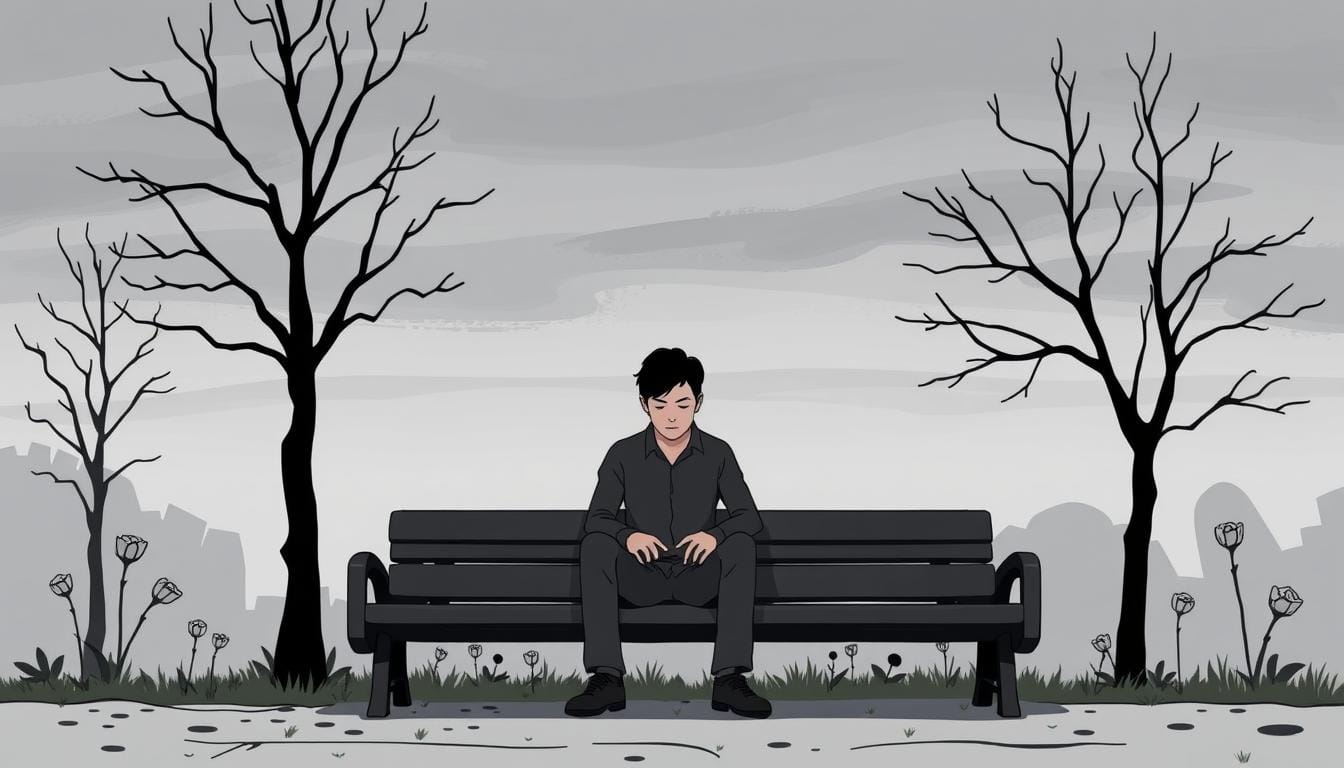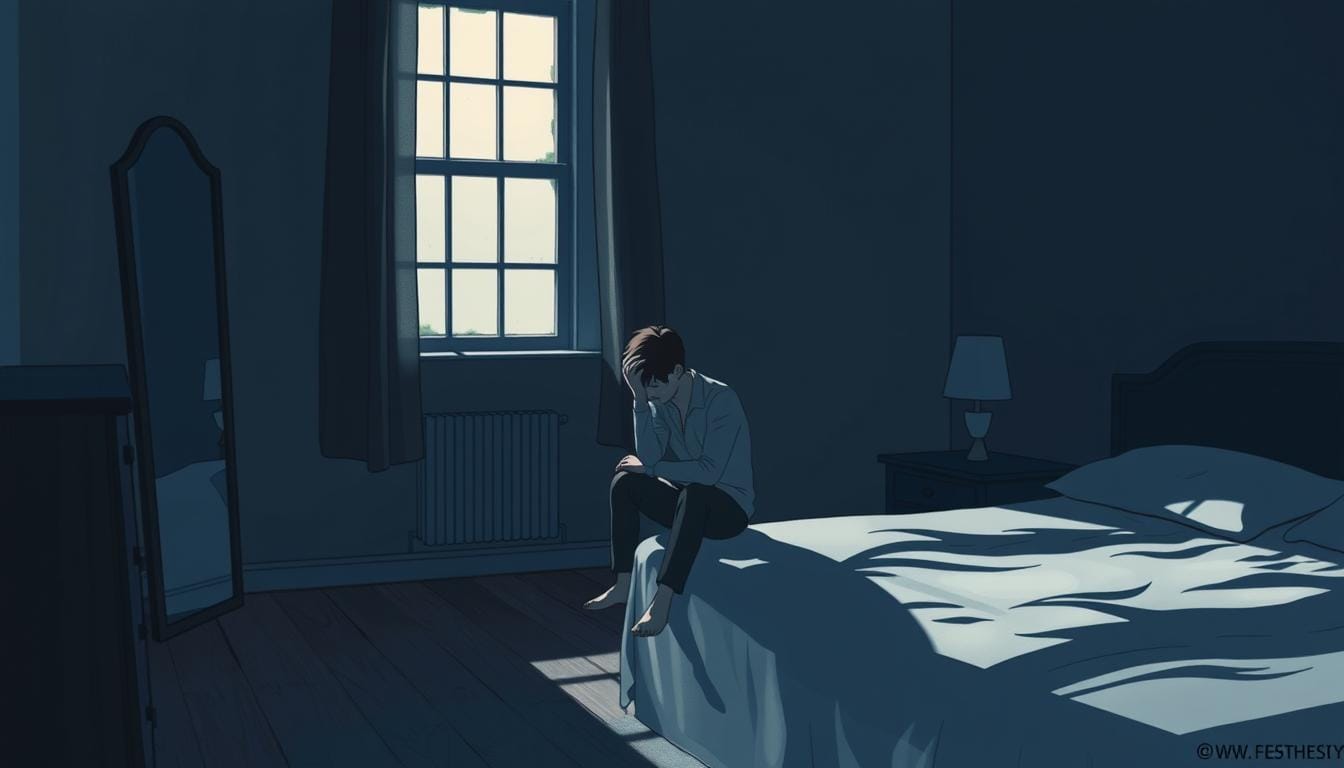If you’re dealing with severe or hard-to-treat depression, you might have heard of electroconvulsive therapy (ECT). ECT is a treatment that uses small electric currents to the brain to cause a brief seizure. It can help with symptoms of certain mental health issues, especially depression.
In this article, we’ll dive deep into ECT, with insights from Dr. Chandril Chugh, a top neurologist. You’ll find out when ECT is suggested, how it works, and what happens during and after treatment. By the end, you’ll know if ECT could be right for your mental health.
Table of Contents
ToggleUnderstanding Electroconvulsive Therapy (ECT)
Electroconvulsive Therapy (ECT) is a treatment for mental health issues. It has been used for many years. It involves sending small electric currents to the brain to cause a brief seizure.
The goal is to help people with severe mental health problems. These problems can make life very hard.
What is ECT?
ECT has been around since the 1930s. It helps with severe mental health issues. A patient gets a brief electric shock to the brain, causing a controlled seizure.
This treatment is given 2-3 times a week for 3-4 weeks. Most people need 6-12 sessions.
History and Evolution of ECT
The first use of ECT was in the 1930s. Italian psychiatrists Ugo Cerletti and Lucio Bini found it helped. They discovered that seizures could ease mental illness symptoms.
Over time, ECT has gotten safer and more effective. Now, it uses anesthesia and muscle relaxants. The placement of electrodes has also improved.
Today, ECT is a top treatment for severe depression and other mental health issues. It still has risks, like memory loss. But, the benefits often outweigh the risks, especially for those who haven’t responded to other treatments.
When is ECT Recommended?
Electroconvulsive Therapy (ECT) is for people with severe, lasting depression. It hasn’t worked with other treatments like medicines and talk therapy. ECT also helps with bipolar disorder, schizoaffective disorder, and catatonia.
Types of Depression Treated with ECT
ECT works well for these types of depression:
- Severe major depressive disorder
- Treatment-resistant depression
- Depression with psychotic features
- Depression with suicidal thoughts
Other Conditions Treated with ECT
ECT is also used for:
- Bipolar disorder
- Schizoaffective disorder
- Catatonia
- Neuroleptic malignant syndrome
Choosing ECT depends on the patient’s symptoms and medical history. It’s considered when other treatments fail or the condition is severe.
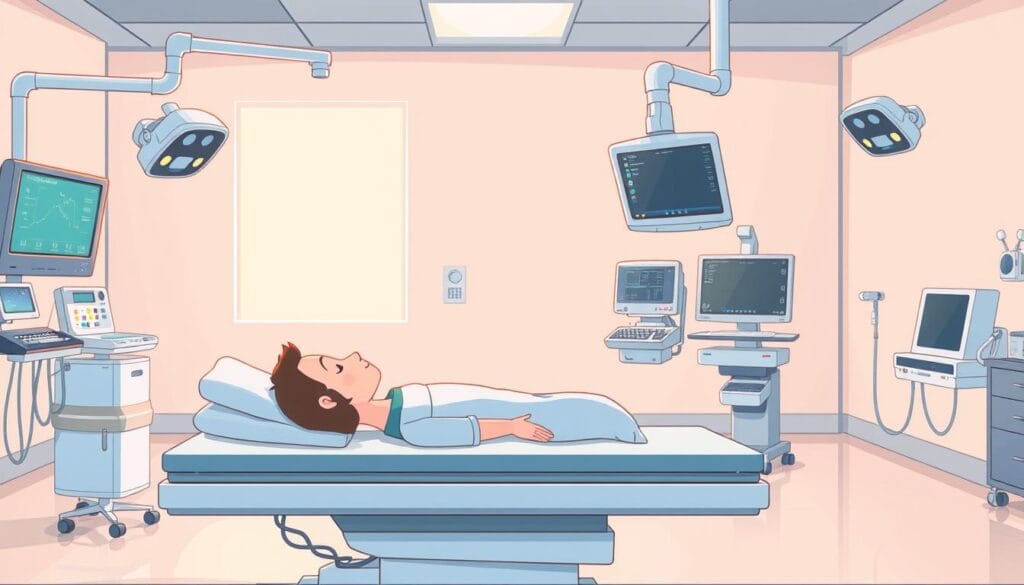
How Electroconvulsive Therapy Works
Electroconvulsive Therapy (ECT) is a top treatment for depression and some mental health issues. The ECT procedure sends a brief, controlled electrical current to the brain. This causes a 30-second seizure.
The patient is watched closely during the whole process.
The ECT Procedure
Before the ECT, the patient gets general anesthesia and a muscle relaxant. This prevents muscle movements during the seizure. Electrodes are placed on the head, and the electrical current is given.
This starts the seizure. The type of electrode placement can change based on the patient’s needs.
Effects of ECT on the Brain
- ECT changes the brain’s chemistry and pathways. This can improve mood and overall health.
- Studies show ECT can activate genes through DNA repair. This might help it work.
- Imaging shows changes in brain activity after ECT. This suggests it can fix abnormal brain functions.
The effects of ECT on the brain are complex. Research is ongoing to understand how ECT works to help mental health.
Preparing for Electroconvulsive Therapy
Before starting electroconvulsive therapy (ECT), patients get a full medical check-up. This includes physical exams, blood tests, and checks on the brain. It makes sure the treatment is safe and right for them.
Patients might also need to change or stop some medicines. This is because some medicines can affect how ECT works.
On the day of ECT, patients can’t eat or drink for a while. This is to keep them safe during the treatment. They will be watched closely to make sure they are okay.
During ECT, a small electric current is sent to the brain while the patient is asleep. This causes a short, helpful seizure. It can help with severe depression and other mental health issues. Even though it sounds scary, ECT is safe and effective when done by experts.
Knowing what to expect before and during ECT can make patients feel more ready. By working with their healthcare team, patients can help make the treatment work best for them.
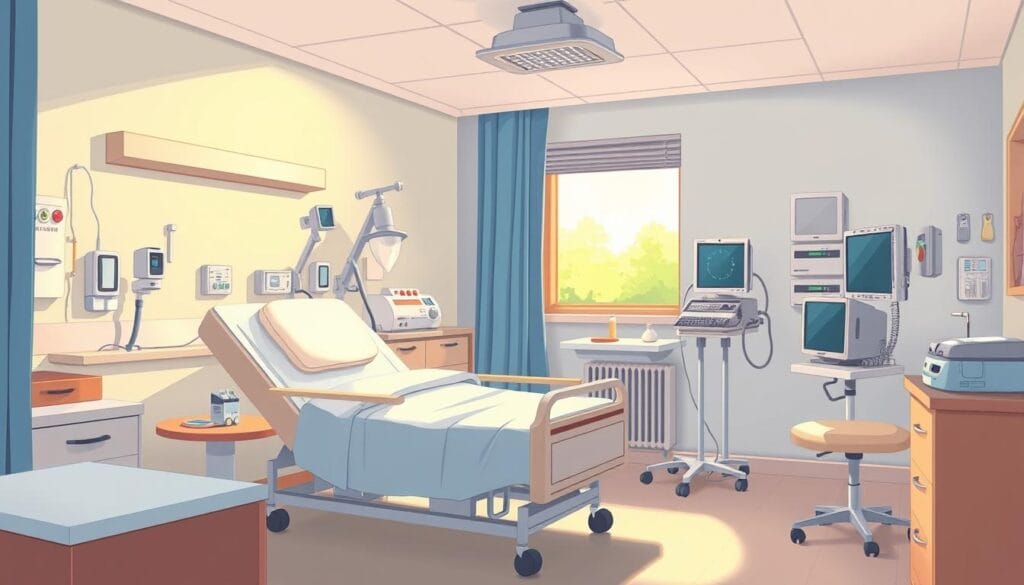
Choosing ECT is a big decision. It’s important to talk openly with your doctor about your worries and hopes. With the right help and support, ECT can change lives for those with severe mental health problems.
Electroconvulsive Therapy For Depression
Electroconvulsive therapy (ECT) is a top choice for treating severe, hard-to-treat depression. It greatly improves mood, thinking, and life quality for those with depression. In fact, it works for 70% to 90% of patients, making it a strong ally against depression.
Effectiveness of ECT for Depression
ECT has been around for over 80 years to treat mental health issues, including depression. It induces a controlled brain seizure to reset brain paths and ease depression. For those who didn’t get better with usual treatments, ECT can be a big help, offering quick and clear improvements.
Potential Side Effects and Risks
Though ECT is safe and effective for depression, it has risks. Side effects might include short-term memory loss, confusion, headaches, and rarely, serious heart or stroke issues. It’s key to talk about these risks with your doctor before starting ECT.
Modern ECT, with anesthesia and better tools, has lowered side effect risks. The benefits of ECT often outweigh the risks, especially for those with severe, hard-to-treat depression.
Choosing ECT should be a team decision with a healthcare expert. They can balance the good and bad for each patient. With careful steps and watchful care, ECT can be a safe, effective way to fight depression.
Aftercare and Maintenance
After ECT for depression, it’s key to focus on aftercare and maintenance. This helps keep the treatment’s benefits going. Right after ECT, patients are watched closely to make sure they’re safe and okay. They might feel confused or forget things for a few days, but these side effects usually go away soon.
Follow-up Care
Regular follow-up care is very important for managing depression after ECT. This includes ongoing therapy, managing medications, and check-ups with the healthcare team. They will tell patients not to drive or do things that need focus until they feel better.
Preventing Relapse
- Living a healthy lifestyle, like exercising, eating well, and managing stress, helps keep ECT benefits and prevents relapse.
- Outpatient maintenance ECT might be suggested to keep patients well and stop depression from coming back.
- Studies show that ECT and antidepressant meds together work better to stop relapse than either one alone.
By focusing on ECT aftercare, ECT follow-up care, and ways to prevent relapse after ECT, patients can get the most out of this effective treatment for depression.

Myths and Misconceptions about ECT
Many myths and misconceptions still surround electroconvulsive therapy (ECT). Some believe it’s painful or dangerous. Others think it causes permanent brain damage or is only used when all else fails.
But, modern ECT is safe and effective. Research shows it’s much safer than general anesthesia in surgery. It has a very low death rate.
Studies prove ECT works well for severe depression. About 50% to 60% of patients find relief. Up to 90% see improvement when treating depression with psychosis.
Some think ECT is a “miracle cure.” But, it’s not a quick fix. It takes six to 12 treatments to see results. It’s a long-term treatment that needs ongoing care.
By clearing up these myths, we can better understand ECT. It’s a safe and effective treatment for severe mental health issues.
Deciding on ECT: Weighing Pros and Cons
Choosing to have electroconvulsive therapy (ECT) for depression is tough. It’s key to think about the good and bad sides before deciding. ECT works well for severe or hard-to-treat depression, helping up to 90% of people feel better fast.
ECT is a strong treatment that works quickly for those who haven’t gotten better with other treatments. About 70 to 90 percent of people with ECT feel a big improvement. It’s also safe for pregnant women, teens, and older adults.
But, ECT has some downsides. The main one is short-term memory loss. This usually goes away in 1 to 6 months after treatment ends. Other side effects like headaches, confusion, nausea, and muscle stiffness are rare and usually mild.
Talking to your doctor is crucial when thinking about ECT for depression. They can help you understand the pros and cons of electroconvulsive therapy based on your situation. With their help, you can decide if deciding on ECT is right for you.
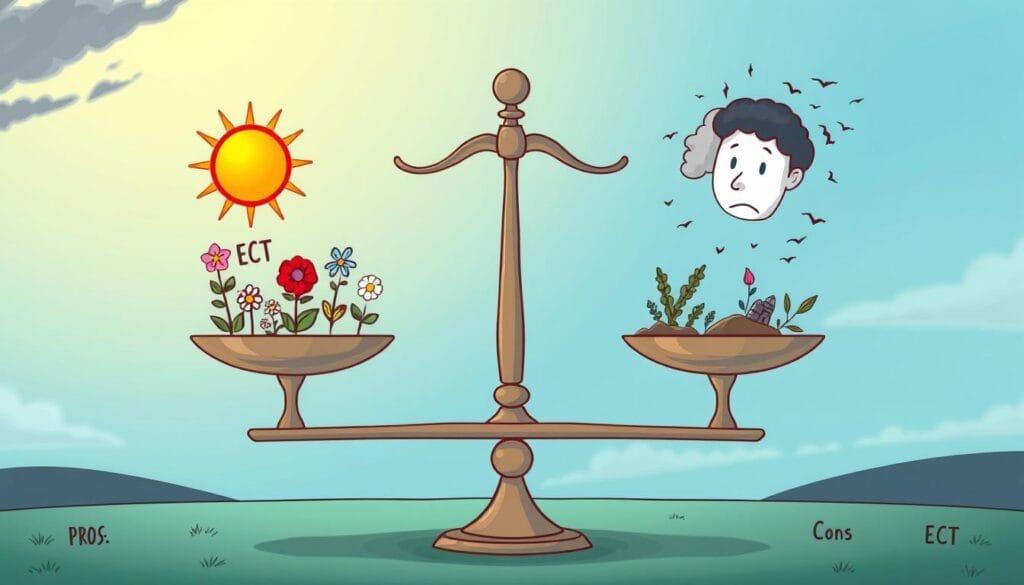
Choosing ECT is a personal decision. Make sure to talk to your doctor about your worries and what you want. This way, you can find the best way to take care of your mental health.
Finding a Qualified ECT Provider
When you look for electroconvulsive therapy (ECT) treatment, it’s key to find a skilled provider. These can be psychiatrists, neurologists, or other mental health experts. They should have special training and know-how in ECT.
Patients should look for providers who are board-certified and have lots of ECT experience. They should also work in places that are safe and follow the rules.
Choosing the right ECT specialist is very important. They will make a treatment plan just for you. They will also make sure the treatment is safe and works well.
It’s important to find someone who explains everything clearly. They should answer your questions and help you through the whole process.
Look for ECT providers who are board-certified and have extensive experience in administering the procedure.
Ensure the healthcare facility where the ECT treatment will be performed is accredited and follows established safety protocols.
Work with an ECT specialist who takes the time to explain the procedure, address your concerns, and develop a personalized treatment plan.
By finding a qualified ECT provider, you can have a better chance of a successful treatment. This can really help your mental health and improve your life. Remember, your health is the most important thing. So, take your time to find the right ECT specialist for you.
Conclusion
Electroconvulsive therapy (ECT) is a very effective treatment for severe depression and other mental health issues. It may have some risks and side effects. But, it is safe and well-proven when done by experts like Dr. Chandril Chugh.
Knowing the benefits, how it works, and the precautions helps patients decide if ECT is right for them. With the help of skilled doctors, patients can try this therapy. This can lead to better mental health and a better life.
Studies show ECT is very effective, especially when used with psychotherapy. It’s better than other treatments like repetitive transcranial magnetic stimulation. It can also work well with ketamine to improve results. If you’re facing mental health challenges, talk to your doctor about ECT. Think about the good and bad points to see if it’s right for you.
FAQ
What is electroconvulsive therapy (ECT)?
ECT is a treatment that uses small electric currents to the brain. It triggers a brief seizure. This helps with severe mental health issues, like depression.
When is ECT recommended?
Doctors use ECT for severe depression that doesn’t get better with other treatments. It’s also for bipolar disorder, schizoaffective disorder, and catatonia.
How does ECT work?
First, patients get anesthesia and a muscle relaxant. Then, electrodes are placed on their head. A brief electric current is given, causing a 30-second seizure.
ECT changes the brain’s chemistry and pathways. This leads to better mood and overall health.
What can patients expect during and after ECT?
During ECT, patients are closely watched. They might feel confused or forgetful, but these side effects go away in a few days.
After, they should not drive or do things that need focus until they feel better.
How effective is ECT in treating depression?
ECT is very effective for severe depression, with success rates of 70% to 90%. It improves mood and quality of life for many patients.
What are the potential risks and side effects of ECT?
ECT is safe but has risks. These include memory loss, confusion, headaches, and rare serious problems like heart issues or strokes.
Patients should talk to their doctor about the benefits and risks before ECT.
How can patients find a qualified ECT provider?
Finding a good ECT provider is key. Look for a psychiatrist, neurologist, or mental health expert with ECT training.
Choose someone who is board-certified and has lots of ECT experience. They should work in a safe, accredited place.
Source Links

This article is medically reviewed by Dr. Chandril Chugh, Board-Certified Neurologist, providing expert insights and reliable health information.
→ Book a consultation to discover which remedies suit your needs best.
About Author | Instagram | YouTube | Linkedin



